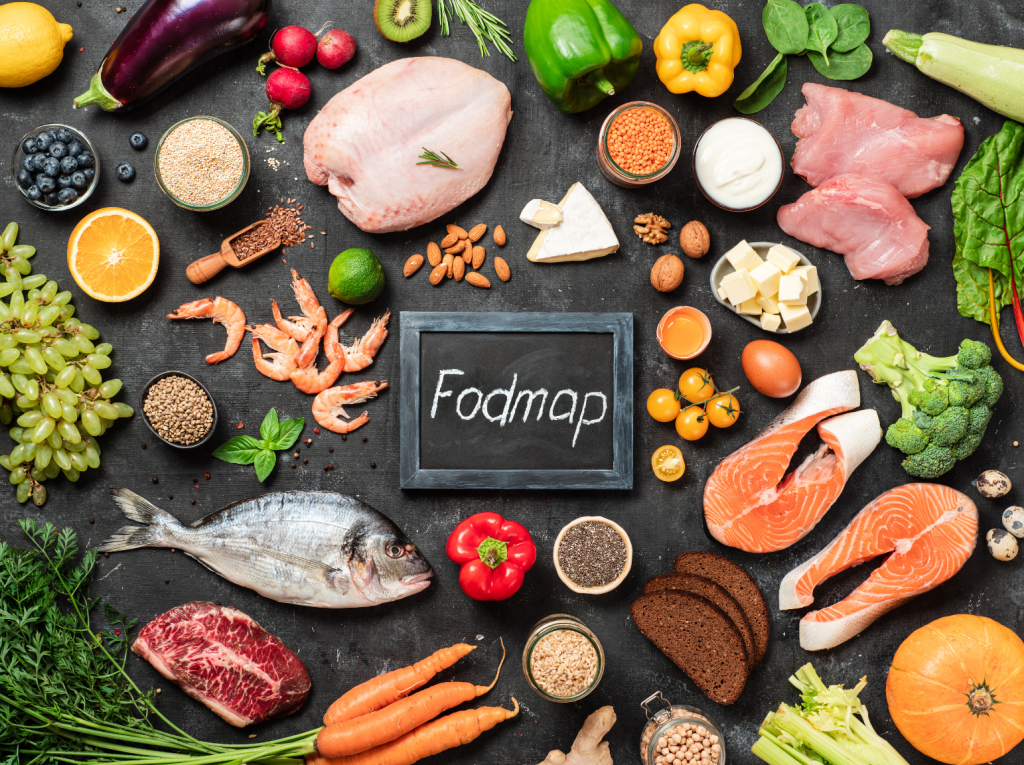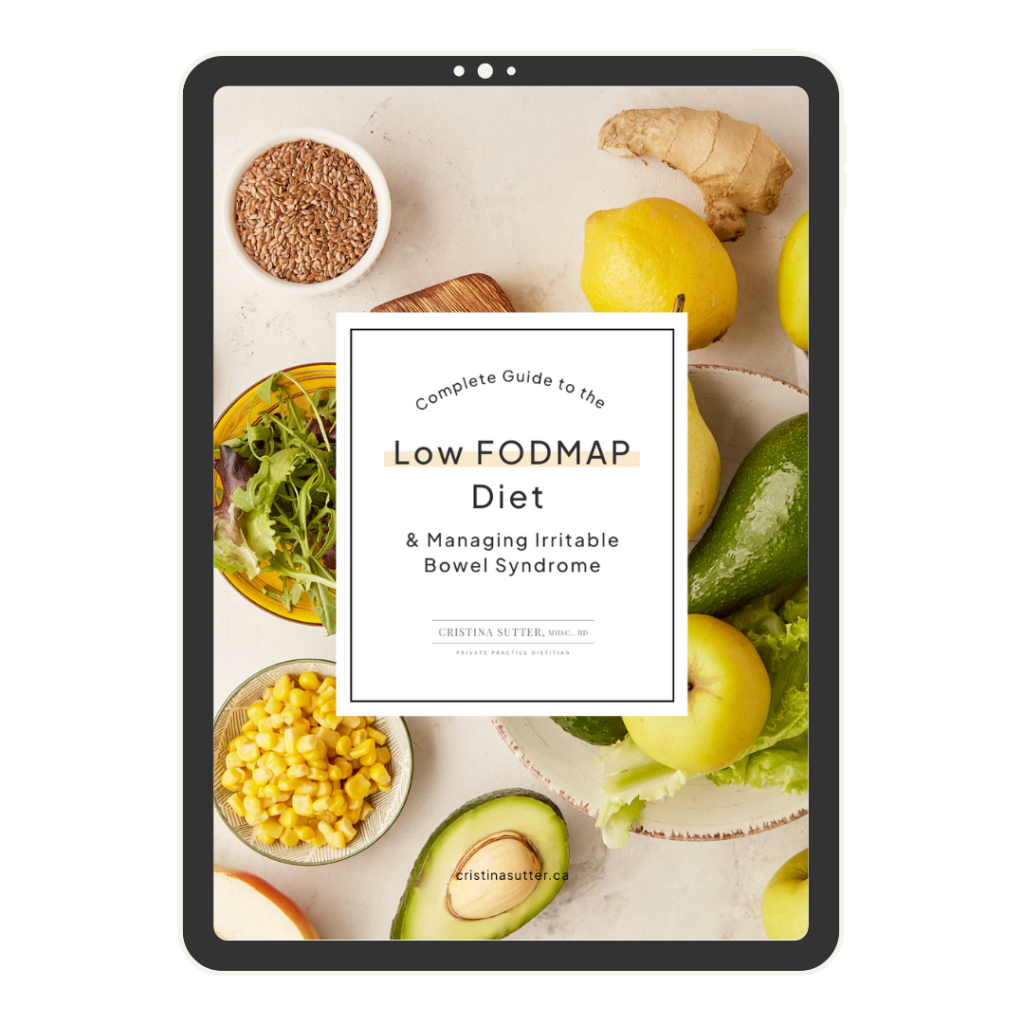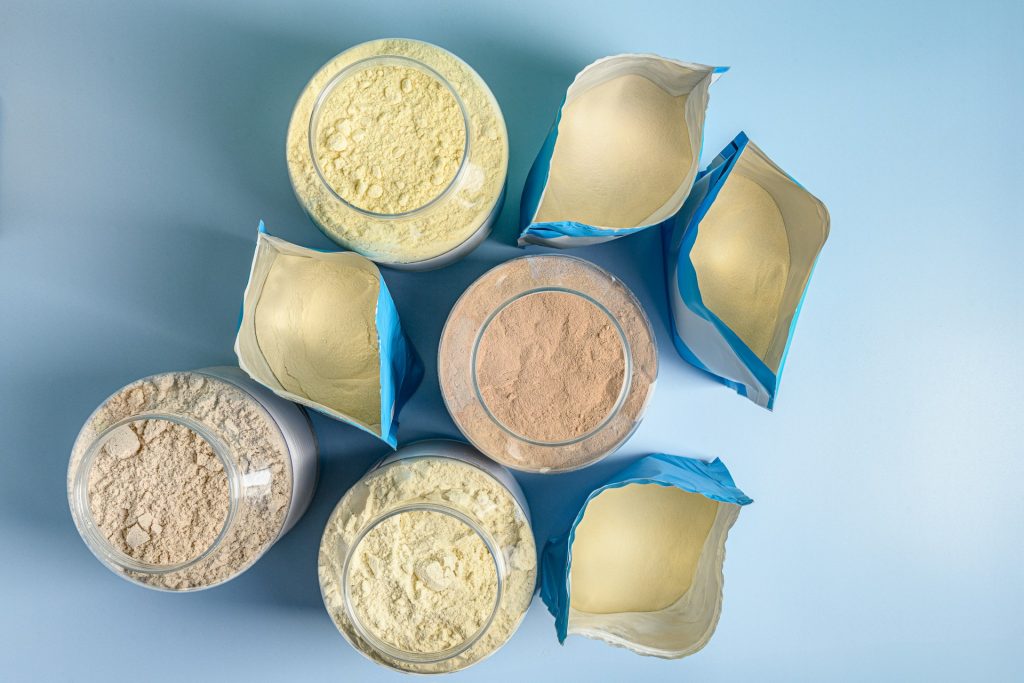Here is a Complete Guide to the 3 Phases of the FODMAP Diet with pro tips from a dietitian to help you navigate them all. The FODMAP diet is an evidence-based diet that improves symptoms in 75% of people living with Irritable Bowel Syndrome (IBS). In Phase 1, you cut out FODMAP foods for a month to see symptom relief. Phase 2 involves trying key FODMAP foods to test your tolerance threshold. Phase 3 is finding a sustainable way to moderate a balance of fodmap and complement them with supplements as needed. It is important to move through all three phases to avoid staying on the overly restrictive low FODMAP diet, which can negatively impact your gut health.
Phase 1: The FODMAP Elimination Diet (4 weeks)
For these four weeks, you need to strictly avoid high-FODMAP foods carefully. For many people their symptoms improve significantly by the end of Phase 1. Symptoms may not go away completely, but they should get a LOT better.
- After 4 weeks, if your symptoms improve, congratulations! You are ready for Phase 2 Reintroduction.
- After 4 weeks, if your symptoms do not improve and you are sure you followed the diet carefully, you may talk to your doctor or dietitian about one of the other treatments for IBS. There are several evidence-based treatments for IBS including gut-directed hypnotherapy, natural supplements, and prescription medications. Read about the Four Ways to Treat IBS in my blog. **hyperlink**
5 Tips Before You Start the FODMAP Elimination Diet:
- Be sure that you have IBS and the FODMAP diet is recommended for you. Talk to your doctor or dietitian who can ensure that the FODMAP diet is recommended for you. This diet is not appropriate for everyone. People recovering from eating disorders, vegans and children should not follow an elimination diet. People following a vegetarian diet can work with a dietitian to ensure they are still meeting their nutritional needs while eating a modified fodmap diet with digestive enzymes.
- Plan to do this phase when you can easily make your own meals and don’t have a lot of special occasions, restaurants, travel or eating out planned.
- Work with a dietitian for this phase to get a meal plan that optimizes nutrition, portion sizes and includes low fodmap foods that you enjoy.
- Buy the Monash University FODMAP Diet app when starting the low FODMAP diet, as the list and serving sizes of fodmap foods is complicated and constantly changing.
- Keep a food symptom journal for 4 weeks to track your symptom progress, identify any trigger foods that may have snuck into your diet and monitor other factors like stress that can affect your symptoms.
How a digestive dietitian can help during Phase 1:
- Create an easy meal plan customized to your needs and preferences.
- Give you the brand names of your favorite granola bars, protein powders, seasoning and cereals that work with the low fodmap diet.
- List low-fodmap recipes and restaurant meals.
- Explain the serving sizes of each food.
What foods should you expect to change?
Here are some easy swaps when removing FODMAP foods from your diet:
| AVOID THESE FODMAPS | TRY THESE LOW FODMAPS INSTEAD |
| Garlic | Garlic infused oil |
| Onion | Green parts of green onion, chives |
| Dairy | Lactose free milk, cheese, yogurt, ice cream |
| Bread | Sourdough or low fodmap bread (at Cobbs) |
| Pasta | GF corn/rice pasta |
| Almonds | Walnuts |
| Kale | Spinach |
| Apples | Oranges |
| Vegan protein shake made from pea protein | Low fodmap protein shake |
| Larabar, RX bar | Gomacro bar, Made good bar, Cliff bar |
| Premier protein bar | Kirkland protein bar |
| mangoes, | pineapple |
| watermelon | Cantelope, honeydew |
| Raspberries, blackberries | Blueberries, strawberries |
| cherries | grapes |
| applesauce | Pumpkin puree |
| Flour tortillas | Corn tortillas |
| Pretzels or crackers | Rice crackers or potato chips |
| Onion powder | Parmesan cheese, Nutritional yeast |
| Hummus | Sourcream |
| Honey garlic sausages | Black forest ham |
| Avocado | Seed butter |
Phase 2: The FODMAP Reintroduction / Challenge takes 6-8 weeks
If you have followed Phase 1 The Elimination Phase and your symptoms have improved, then it is important to progress to Phase 2. In Phase 2, you will learn how much of each FODMAP foods you can consume, before symptoms return. Reintroduction involves testing one FODMAP food at a time, in incremental portions. Essentially you are discovering your tolerance level of each category of food.
5 Tips Before You Start the FODMAP Reintroduction Phase:
- Wait until your symptoms have resolved, before challenging a new FODMAP.
- Use the “Diary” section in Monash University FODMAP Diet app when starting the reintroduction phase. The diary section will tell you which foods to try and the portions to try.
- Challenge one food over 3 days: Start with a small portion on Day 1, a medium portion on Day 2 and your usual full portion on Day 3. Take a 2-3 day break between challenges or until symptoms settle.
- Keep a food symptom journal to track your symptoms after each food challenge.
- Keep following the low fodmap diet for the reintroduction phase, so you are only trying one high fodmap food at a time.
How a digestive dietitian can help during Phase 2:
- Interpret your food symptom journal to assess which foods connect to which symptoms.
- Identify hidden fodmaps and other factors that can affect your symptoms.
- Help determine which FODMAPs you can tolerate and what serving size to stick to.
Phase 3: The FODMAP Personalization long term lifestyle
Once you have completed the reintroduction, you will know which foods you can tolerate, in what amounts. Remember that most people get optimal results when they use a combination of the Four Ways to Treat IBS **LINK.
5 Tips to Personalize your FODMAP Diet:
- You can start to combine various high fodmap foods that you previously have tested on their own.
- If there is a high FODMAP food that you love and miss but you failed the reintroduction, take digestive enzymes next time you want to eat it.
- Psyllium can be taken long term to help regulate your stools.
How a digestive dietitian can help during Phase 3:
- Find a balance of moderate fodmaps that works with your preferences and tolerance.
- Recommend which daily supplements can help improve your digestive symptoms long term.
- Recommend which supplements to take when you want to have a high fodmap cheat!
- Identify whether the gut-brain axis may be interfering with your results and whether you stress reduction or a type of therapy that can help.
The FODMAP diet is hard to follow, restrictive and yet still it is totally worth it to get rid of your bloat! Don’t go it alone, work with a digestive dietitian and resolve symptoms quickly, so you can enjoy your food. Book your appointment today.
What does an actual sport dietitian mom with IBS eat?
With so many high fodmap foods to avoid, it can be overwhelming to figure out what to eat. I am a busy mom and I cook for my family of four who will object if meals taste too healthy or bland. Here is an IBS-friendly low fodmap sample meal plan, with real meals and snack ideas that I have on a regular basis. Download my low fodmap meal plan to see what a sport dietitian living with IBS eats!








